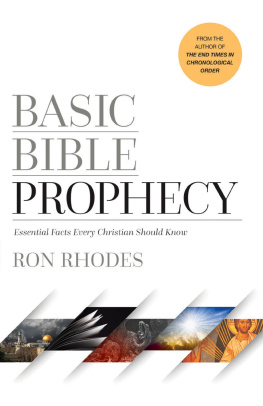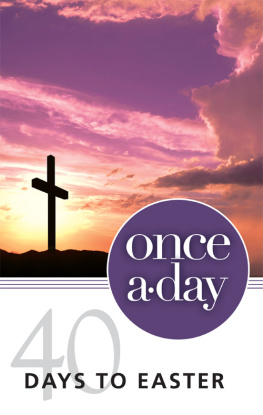

HARVEST HOUSE PUBLISHERS
EUGENE, OREGON
Unless otherwise indicated, all Scripture quotations are from The ESV Bible (The Holy Bible, English Standard Version), copyright 2001 by Crossway, a publishing ministry of Good News Publishers. Used by permission. All rights reserved.
Verses marked NIV are taken from the Holy Bible, New International Version, NIV. Copyright 1973, 1978, 1984, 2011 by Biblica, Inc. Used by permission. All rights reserved worldwide.
Verses marked NASB are taken from the New American Standard Bible, 1960, 1962, 1963, 1968, 1971, 1972, 1973, 1975, 1977, 1995 by The Lockman Foundation. Used by permission. (www.Lockman.org)
Cover by Dugan Design Group, Bloomington, Minnesota
Cover photos AnnekaS / Bigstock; Volodymyr Horbovyy / Shutterstock
90 DAYS THROUGH THE NEW TESTAMENT IN CHRONOLOGICAL ORDER
Copyright 2015 Ron Rhodes
Published by Harvest House Publishers
Eugene, Oregon 97402
www.harvesthousepublishers.com
Library of Congress Cataloging-in-Publication Data
Rhodes, Ron.
90 days through the New Testament in chronological order / Ron Rhodes.
pages cm
Includes bibliographical references.
ISBN 978-0-7369-6431-9 (pbk.)
ISBN 978-0-7369-6432-6 (eBook)
1. Bible. New TestamentCriticism, interpretation, etc. I. Title. II. Title: Ninety days through the New Testament in chronological order.
BS2361.3.R49 2015
225.6dc23
2015000617
All rights reserved. No part of this electronic publication may be reproduced, stored in a retrieval system, distributed, or transmitted in any form or by any meanselectronic, mechanical, digital, photocopy, recording, or any otherwithout the prior written permission of the publisher. The authorized purchaser has been granted a nontransferable, nonexclusive, and noncommercial right to access and view this electronic publication, and purchaser agrees to do so only in accordance with the terms of use under which it was purchased or transmitted. Participation in or encouragement of piracy of copyrighted materials in violation of authors and publishers rights is strictly prohibited.
To Kerri, David, and Kylie
Kerri, David, and Kylie
The sun seems to shine brighter with you in my world!
What an awesome family the Lord has given us.
All my friends at Harvest House Publishers
Your collective efforts have spiritually enriched multitudes around the globe.
I feel privileged to work with you!
C ONTENTS
Thank you for joining me on this exciting journey through the New Testament. You are in for a spiritually uplifting time! My hope and prayer is that as you read 90 Days Through the New Testament in Chronological Order , you will
experience a growing love for the Word of God,
grow in your knowledge of and appreciation for the wondrous salvation you have in Jesus Christ,
experience more daily intimacy with Jesus than ever before,
understand and experience Gods incredible grace in your daily walk with Him,
grow in your knowledge of the Holy Spirit and dependence on Him as He empowers you to live the Christian life,
grow in your faith and trust in God in the midst of lifes troubles, and
gain an eternal perspective so that you see lifes problems and difficulties from heavens vantage point.
As we begin our journey together, I want to address a few things that will lay a foundation for better understanding the New Testament. Lets look at the big picture first and consider some preliminary matters about how this book is arranged. Then we will zero in on our chronological study of the New Testament.
The Significance of the New Testament
The New Testament is a collection of 27 writings composed over a 50-year period by nine different authors from various walks of life. The primary personality of the New Testament is Jesus Christ. The primary theme is salvation in Jesus Christ, based on the new covenant.
The word testament refers to a covenant or agreement. The Old Testament focuses on an old covenant between God and the Israelites. According to that covenant (the Sinai covenant), the Jews were to be Gods people and render obedience to Him, and in return God would bless them (Exodus 19:3-25). Israel failed repeatedly and continually violated this covenant. So even in Old Testament times, the prophets began to speak of a new covenant that would focus not on keeping external laws but on an inner reality and change in the human heart (Jeremiah 31:31). Unlike the Sinai covenant, the new covenant was to make full provision for the forgiveness of sins.
When Jesus ate the Passover meal with the disciples in the upper room, He spoke of the cup as the new covenant in my blood (Luke 22:20; see also 1 Corinthians 11:25). Hebrews 7 demonstrates that Christs priesthood is superior to the old priesthood, and it logically follows that such a superior priesthood would have a superior ministry. Such a ministry is provided for in the new covenant. Jesus has done all that is necessary for the forgiveness of sins by His once-for-all sacrifice on the cross. This new covenant is the basis for our relationship with God in the New Testament.
The Books of the New Testament
The first four books of the New Testament are the Gospels: Matthew, Mark, Luke, and John. Each of these contains an account of the life of Christ. None portrays all the details of His life, but taken together, they provide a full composite account.
Each Gospel author included different details, depending on his purpose for writing. For example, the Gospel of Matthew has more citations from the Old Testament than any other Gospel because Matthew sought to prove to the Jews that Jesus is the Messiah prophesied in the Old Testament. Mark, by contrast, had no such Jewish motivation, but instead sought to portray Jesus in action rather than as a teacher. Lukes Gospel stresses the wonderful blessings of salvation for all people. Johns Gospel focuses heavily on the identity of Jesus and thoroughly demonstrates His deity.
Following the Gospels is the book of Acts, which traces the spread of Christianity following the death and resurrection of Christ. Though the book is traditionally understood as the acts of the apostles, it is probably more appropriately understood as the acts of the Holy Spirit, for truly it is the Holy Spirit who seems to be active in just about every chapter of the book.
Following the book of Acts are the epistles, or letters. The apostle Paul wrote 13 of these, and the rest were written by other followers of Jesus. Many of the New Testament epistles were written to brand-new churches that had certain issues that needed to be addressed (1 and 2 Thessalonians are examples). The apostle Paul often wrote letters to follow up his missionary visits to churches. (For example, Paul wrote Ephesians following his visit to the church at Ephesus.) Therefore, Pauls letters are often personal. In some cases, Paul gave advice to the leader of a particular church. (Such was the case when Paul wrote 1 Timothy.) Other times he addressed the church as a whole. (Philippians is a good example.)
Other New Testament epistlesthe general epistleswere not directed at specific churches, but were circulated to a number of churches and dealt with general concerns. These are primarily the non-Pauline epistles, such as James; 1 and 2 Peter; and 1, 2, and 3 John.
Though the epistles were originally written for first-century Christians, they have tremendous relevance for Christians today. Indeed, the issues dealt with in the epistles are relevant to every generation. We need spiritual instruction just as the ancients did.
Next page



















